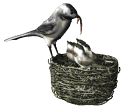



Most animals have the following characteristics:
Animals with backbones are vertebrates. Animals without a backbone are invertebrates. Body symmetry, degree of cephalization, type of gut, type of body cavity, and presence or absence of segmentation are key characteristics in invertebrate evolution and in distinguishing the different groups.
As illustrated in this evolutionary lineage, radial and bilateral symmetry led to two major lineages of invertebrates.
Cephalization means having a definite head end, usually with feeding and sensory features.
Some animals (flatworms or Platyhelminthes) are acoelomate. They do not have a coelom but are packed solidly with tissue.
Others, such as roundworms (Nematoda), have a "false" coelom or pseudocoel, not lined with peritoneum.
This animation (no audio) reviews the types of body cavities.
Animals originated during the Precambrian (1.2 billion - 670 million years ago). One hypothesis is that a ciliate like Paramecium became multinucleate and compartmentalized. Another proposes that multicelled animals arose from colonial flagellated organisms like Volvox.
Perhaps the earliest animals resembled the present-day placozoan called Trichoplax. Two layers of cells make up its flattened body that displays no symmetry, no tissues, and no mouth. Its reproductive modes are as yet unknown.
REVIEW: �Major trends in the evolution of animals include
a. cephalization, the development of a definite head region.
b. the development of types of symmetry.
c. variation in coelomic cavities.
d. the development of segments.
e. all of these�
REVIEW: �A digestive tract is said to be complete if it at least�
REVIEW: �Which is NOT a general characteristic of the animal kingdom?
a. multicellularity; most have tissues, many form organs
b. exclusive reliance on sexual reproduction
c. motility at some stage of the life cycle
d. embryonic development during the life cycle�
REVIEW: �Between the gut and body wall of most animals is a _____ .�
PREVIOUS
NEXT
LECTURE 15 INDEX
MAIN INDEX